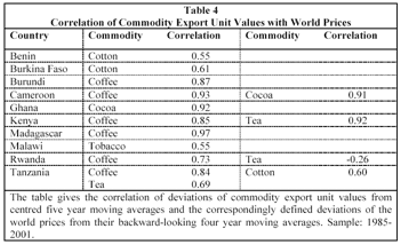Basis risk is the risk that the price which one is using to hedge certain transactions does not move perfectly with the price that one is attempting to hedge – see Hull (1997, pp.32-4). Our concern in this context is that the prices countries obtain for their commodity exports may not be highly correlated with the international prices which we are using in order to construct the required commodity swaps. Table 4 reports these correlations22.
The table shows the long term hedging basis to be generally good for coffee and cocoa and poor for cotton and tobacco. The correlations for tea are mixed. Coffee and cocoa are actively traded on international futures markets in London and New York. These prices are widely disseminated and serve the exporters who purchase in developing country markets. However, exporters may also hedge with the explicit intention of reducing the correlation of export revenues and world prices. Hedging has been particularly important in cocoa.
Cotton is traded in New York, but the New York price relates primarily to the protected US market. The Cotton Outlook (Liverpool A) price which we use as cotton benchmark is based on a survey of supposedly representative trades and is, in that sense, less transparent than a futures market price. It is also less widely disseminated. For tobacco, we are forced to use US import unit values as the world price. This is only modestly correlated with Malawian export unit values.
Tea is more complicated. There is an active cash market in Mombassa, Kenya, and this price is well correlated with Kenyan unit values. The correlation with Tanzanian unit values is less good, and that with Rwandan unit values is actually negative. We conclude that basis risk is high for some country-commodity combinations but acceptable for others.

22 The table excludes gold and oil since for these two commodities we construct export and import values by
multiplying quantities by world prices.
By Prof. Christopher L. Gilbert, Prof. Alexandra Tabova
Next: Quantity Variation
Summary: Index